Best 15 Online Selling Platforms for Ecommerce Brands and Sellers
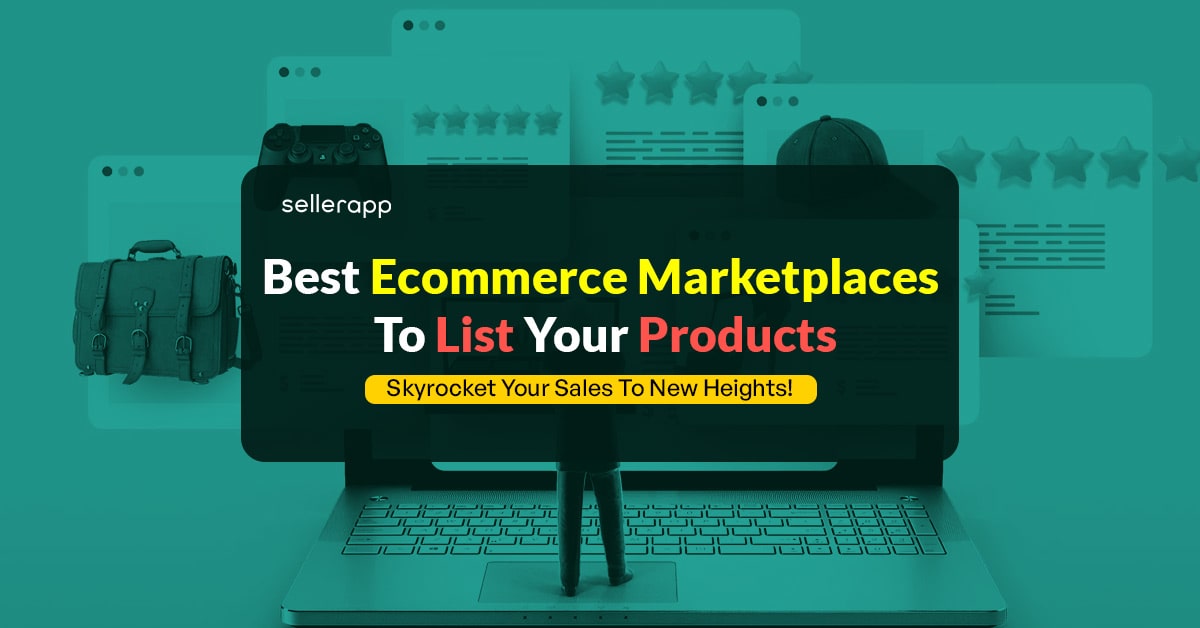
Online selling platforms are very similar to retail locations—get the correct spot on Rodeo Drive, and you’ll see your business thrive. End up in a dead mall, and it’s game over.
Global retail ecommerce sales are projected to reach approximately $4.3 trillion in 2025, according to Statista, with online transactions expected to account for 21% of all retail sales worldwide.
But there is a catch (there always is): succeeding in the fiercely competitive ecommerce marketplace requires more than just listing products and hoping for the best—it demands an advanced and structured strategy.
Before diving in, it’s essential to identify the ideal online selling platforms that are customized to your brand’s specific needs. Each online sales platform has its own set of criteria, product categories, enrollment fees, and target audiences. Thus, conducting thorough research is essential to making informed decisions.
Let’s embark on this journey together and unlock the potential of the top 15 online selling platforms.
Quick Guide
- What is an online selling platform?
- The best marketplaces for global selling: Top 15 online selling platforms
- Which online selling platforms should you choose?
- What are the benefits of selling on online selling platforms?
- Important factors to research before you sell on online selling platforms
- Top 5 countries dominating online selling platforms
- Final Thoughts
What is an online selling platform?
Imagine a supermarket. They sell a variety of products from different brands. Similarly, an international ecommerce platform or an online selling platform is a digital space that hosts products from different brands and multiple independent sellers and vendors from all over the world.
Top online marketplaces act like a one-stop solution for consumers to purchase various categories of items from other brands, yet from a single site as a single purchase.
A better way to view it would be to consider it a middleman connecting buyers with sellers. So, as a seller, you’ll find a collection of tools for listing products, enabling transactions, managing fulfilment, and customer query resolution.
Amazon, eBay, and Alibaba are some of the significant ecommerce marketplaces that hold the highest percentage of market share. Retail giants like Walmart and Tesco have also switched to a hybrid model, where they’ve opened an ecommerce marketplace.
You may wonder how they typically earn revenue for each sale. To answer your question, fees and commissions are levied on sellers who use the platform to obtain customers. Online selling platforms generate the customer base and channel it to the listed products.
The best marketplaces for global selling: Top 15 online selling platforms
Taking your business up to a global level sounds lucrative. Whether you’re a seasoned seller or just exploring international online marketplaces to sell online, choosing the right market can make or break your cross-border success. With more than dozens of online marketplaces catering to different niches, audiences, and regions, the key lies in understanding where your products will thrive best.
To help you navigate this dynamic landscape, we’ve curated a list of the top 15 online selling platforms—each offering unique advantages to power up your global ecommerce game.
1. Amazon
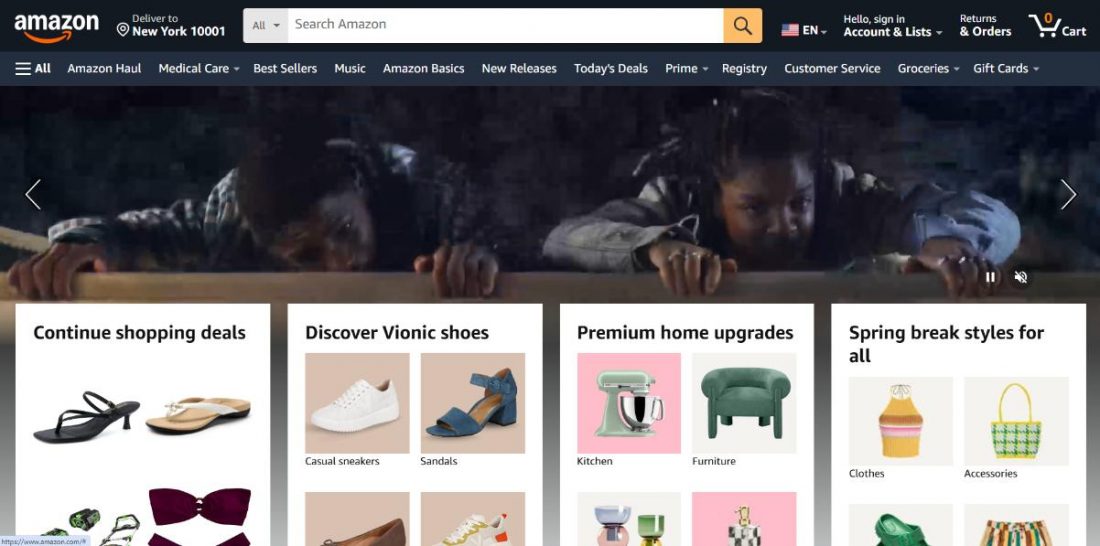
Starting with the highest shareholder in the market— the industry whale, or rather, the expansive Amazon. We can very well compare Amazon ecommerce marketplace with the Amazon rainforest as both are vast, numerous complex ecosystems where survival depends on hierarchy and adaptability according to the environment.
Amazon accounts for almost half the global ecommerce marketplace, making it the largest in the world. This online marketplace platform hit a trillion-dollar valuation back in 2018. But you’ll have to strive for visibility to enter the ecommerce marketplace bustling with 310 million customers globally.
Optimizing your product listing with high-quality images, detailed descriptions, and strategic keywords is mandatory to maximise your visibility. We also recommend using Amazon’s advertising tools— such as Sponsored Products and Sponsored Brands, to boost initial traction.
It can possibly be challenging to make the best use of your ad budget without the guidance of an expert PPC ad agency.
A more enormous international ecommerce platform calls for nuanced features. The marketplace also allows integration with various service providers to ensure complete automation of the selling process.
Additional Read: Amazon Advertising Grading Checklist for 2025.
Amazon marketplace fees
Amazon charges a referral fee (typically 8-15% of the sale price) and a mandatory variable closing fee. There are also FBA fees for storage and shipping if you use their logistics service and stay updated about the Amazon fees.
How to set up an Amazon account
To use this platform to sell products online, follow these simple steps,
- Create an Amazon Seller Central account.
- Choose between an individual or professional selling plan.
- List your products
- Verify your identity and provide the necessary tax and bank details.
If you want a detailed guide on how to set up your Amazon account, check out this Seller Central guide.
Organic Website Traffic in 2025: 785,049,446/month
2. Walmart
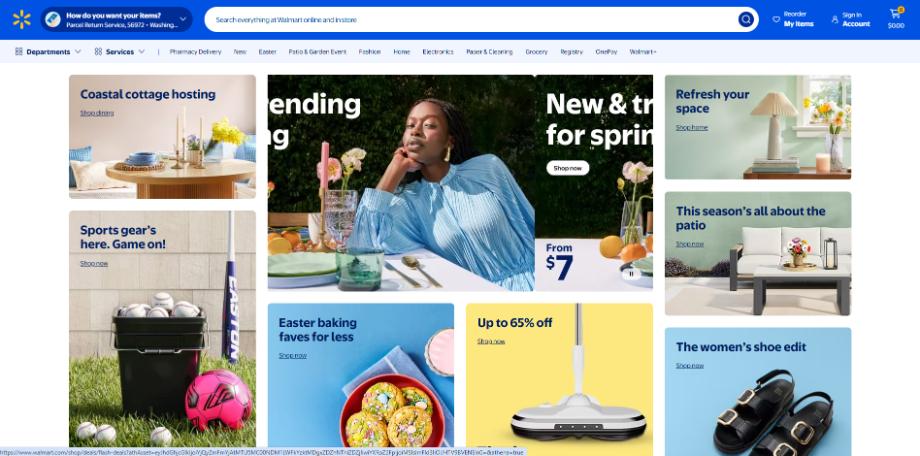
Walmart’s online selling platform is filled with millions of loyal customers from 27 different countries, particularly in the U.S. It serves over 37 million customers daily around the world. That might give you an idea of Walmart’s current position on a global level. To make a good sale at Walmart.com, you have to optimize listings with detailed product information and set competitive pricing.
Third-party sellers can also sell products in any of the 35 categories currently. You can always take advantage of the Walmart Connect program helps you to enhance product visibility. The new seller savings offer now allows new joining sellers to save up to $75K!
You get 75% off base referral fees plus credits when you opt for advertising and fulfilment. Making a position among established brands on Walmart.com can be challenging.
Walmart marketplace fees
Walmart charges a referral fee for its online selling platform, ranging from 5% to 20%, depending on the product category. There are no monthly subscription fees that you need to worry about.
How to set up a Walmart account
To use this platform to sell products online, follow these simple steps,
- Apply to become a Walmart Marketplace seller.
- Complete the registration process.
- Integrate your product catalog.
- Provide your business information.
- Agree to Walmart’s Retailer Agreement.
Organic Website Traffic in 2025: 160,325,474/month
3. eBay
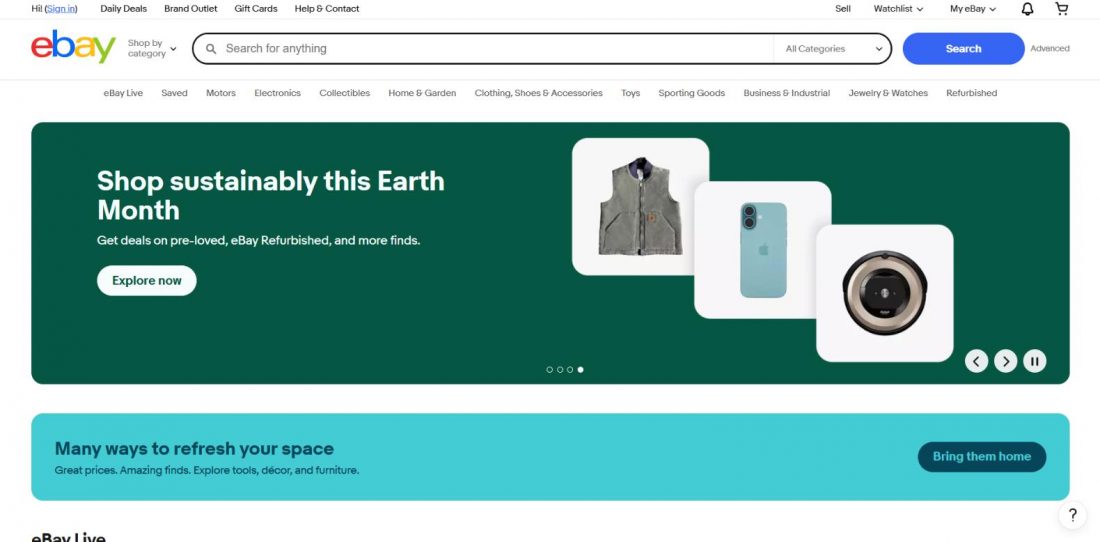
eBay is one of the most versatile C2C and B2C online selling platforms operating in 180+ countries, offering a wide range of products in auction and fixed pricing. You find unique to common objects, ranging from collectables to electronics, within the 1.7 billion+ listings worldwide. The revenue of eBay was approximately $2.576B in 2024. It is the best ecommerce marketplace if you’re willing to sell vintage or thrift products.
Hot tip for sellers to win over eBay’s online marketplace: Use high-quality images and detailed descriptions, and consider auction-style listings to attract bids and drive up prices. Sellers can benefit from eBay’s Global Shipping Program, which allows free shipping country-wide and applies only to US citizens, which is a big offering compared to all other top marketplaces to sell online.
eBay marketplace fees
eBay charges an insertion fee per listing, a processing fee, and a final value fee, typically 13.6% of the sale price, with a 2.5% + $0.25 payment processing fee and additional fees for items over $7,500.
How to set up an eBay account
To use this platform to sell products online, follow these simple steps,
- Create an eBay seller account.
- Set up your payment method through PayPal or eBay Managed Payments.
- List your products.
- You can choose auction or fixed-price formats, unlike other top online marketplaces.
Organic Website Traffic in 2025: 120,029,185/month
4. Etsy

Etsy is a niche ecommerce website to sell products in handmade, vintage, and craft supplies categories, making it a popular option for art lovers.
Be it your handmade items or vintage items that you’ve found in a garage sale that you’re selling on Etsy, optimize listings with clear images, detailed descriptions, and up to 13 tags for best visibility.
Due to the license not being mandatory and the minimal platform fee, Etsy is one of the few online selling platforms that is perfect for emerging businesses. You can engage with the community through Etsy Teams and forums if you want to keep up to date with their changing policies— something that is unique among other online selling platforms.
The shocking growth curve of Etsy shows 9 million active sellers on the platform in 2023, which is almost 1.5 million more than the previous year, 2022, which can help you ascertain its growth trajectory from 2025 forward.
However, Etsy’s policies are not as tightly bound, so they suit the nature of the business, helping people jump-start their handmade businesses, which are also the best platforms to sell handmade online products.
Etsy marketplace fees
Etsy charges a listing fee of $0.20 per item, a 6.5% transaction fee, and a 3% + $0.25 payment processing fee. You can start with as little as $50! This makes it the best ecommerce marketplace to start with a minimal budget if it fits the category.
How to set up an Etsy account
To use this platform to sell products online, follow these simple steps,
- Create an Etsy seller account.
- Set up your shop preferences.
- List your products.
- Customize your shop with a banner, policies, and the About section.
Organic Website Traffic in 2025: 120,029,185/month
Recommended read:
13 Best SEO Tips for Etsy Sellers
Amazon vs. Etsy: What’s the best option for you?
5. Shopify

Shopify is one of the comprehensive online selling platforms in the ecommerce marketplaces, especially dedicated to building your online store. Shopify has made it easy to build a brand. For the best results, you can optimize your site with paid professional themes or the 90+ free themes for starters, SEO tools, and integrated apps.
Use Shopify’s marketing tools, like email campaigns and social media integration, to maximize the reach and engagement of your brand store. You’ll be surprised to know Kylie Cosmetics is a Shopify brand and 10% of ecommerce transactions in the US take place via such Shopify platforms.
Shopify was at a $4.6 bn valuation in 2021 and took a leap to reach $7.06B in 2023.
A 26.1% spurt in growth while Shopify kept picking up the momentum till it landed $7.413 billion in revenue in 2024— a solid 23.2% leap.
In 2025, the international ecommerce platform is projected to reach $4.8 trillion. Shopify’s gross merchandise volume (GMV) has increased by 19.65% in the last year.
Shopify marketplace fees
Shopify charges a monthly subscription fee ($29-$2300/month) and transaction fees if not using Shopify Payments (2% + additional fees).
How to set up a Shopify account
To use this platform to sell products online, followl these simple steps,
- Sign up for a Shopify account.
- Choose a pricing plan.
- Customize your store.
- Add products and configure payment and shipping settings.
- Launch your store because the best platform to sell online is your own website!
Recommended guide: How do Sellers Benefit from Amazon Shopify Integration?
Organic Website Traffic in 2025: 22,837,937/month
6. Target
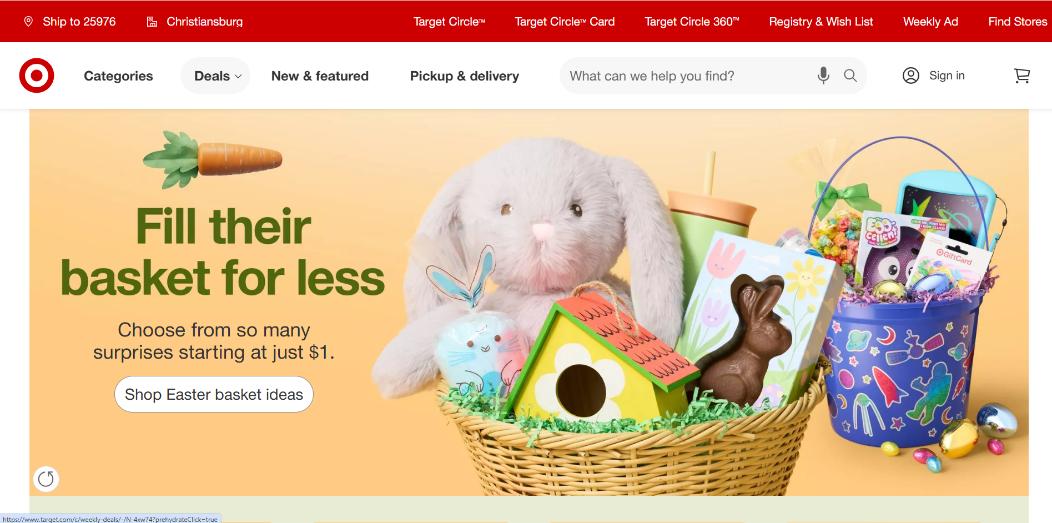
Target’s online selling platform, Target Plus, is an invite-only opportunity for sellers. It focuses on delivering high-quality products by only allowing reputable brands to sell on its website.
Target is in 8th position in the retail online marketplace, and its entire business model is based on retaining loyal customers and offering top brands in terms of quality.
Target’s ecommerce marketplace has witnessed exponential growth from $6.6 billion in 2019 to $22 billion+ in 2022, which solidified its hybrid presence in the evolving market. Target, being one of the best ecommerce sites to sell products, hit a valuation of $107.41 billion in 2023. Now it aims to hit a milestone of $5 billion+ in 2030,
Target marketplace fees
Target Plus charges a commission fee that varies by category but typically ranges between 5% and 15%.
How to set up a Target account
To use this platform to sell products online, follow these simple steps,
- This makes it an online marketplace to sell products from already established brands, so to start, you need to receive an invitation to join Target Plus.
- Complete the registration process.
- Integrate your product catalog.
- Provide your ecommerce marketplace information and agree to Target’s terms.
Organic Website Traffic in 2025: 74,630,076/month
7.Shopee
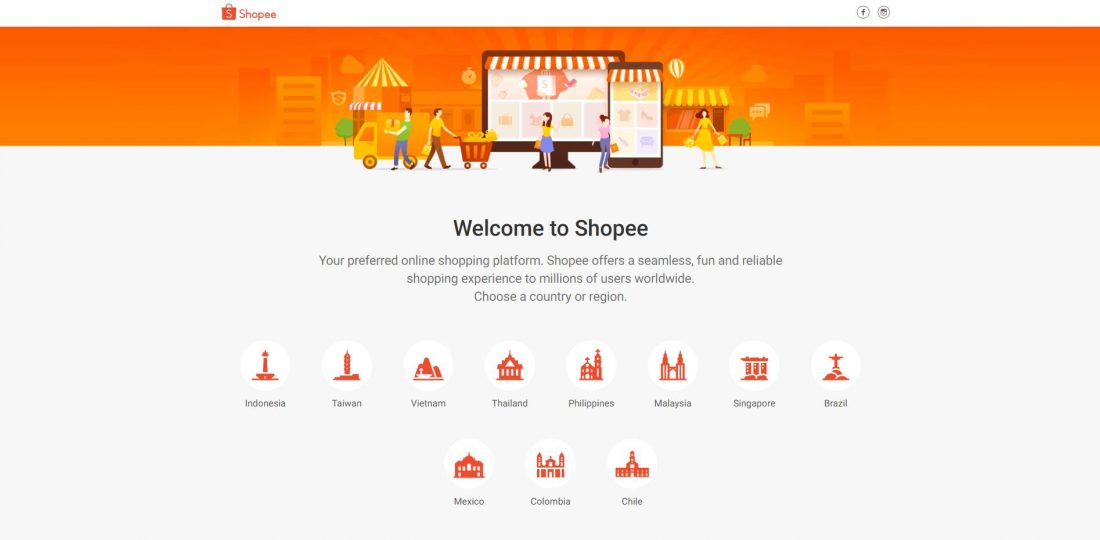
Shopee is one of the most popular online selling platforms in Latin America, Southeast Asia, and Taiwan, originally started out of Singapore. Participate in Shopee’s promotions and flash sales to elevate the sales count each day. Shopee’s Gross Merchandise Value (GMV) touched $23.3 billion in the second quarter of 2024, which proves its growing popularity.
Shopee marketplace fees
If you’re willing to take a chance and sell on Shopee, good news for you. It is among the best ecommerce marketplaces that charges a minimal commission fee that varies by region and product category. The fact that it typically dwells between 1% and 2% makes many interested in choosing Shopee to sell.
How to set up a Shopee account
To use this platform to sell products online, follow these simple steps,
- Download the Shopee app or visit the website.
- Click “Sign Up” and enter your email/phone number.
- Verify your account.
- Complete your profile and start listing products.
Shopee has proven to be an extremely profitable online marketplace for selling. However, this also makes it competitive because, just like most ecommerce marketplaces from the Far East, it focuses on high volume selling more than per unit profit. We recommend sellers take advantage of a Shopee Product API to gather the necessary intelligence to stand out while leveraging the strength of one of the top online marketplaces.
Organic Website Traffic in 2025: 2,189,406/month
8. Alibaba
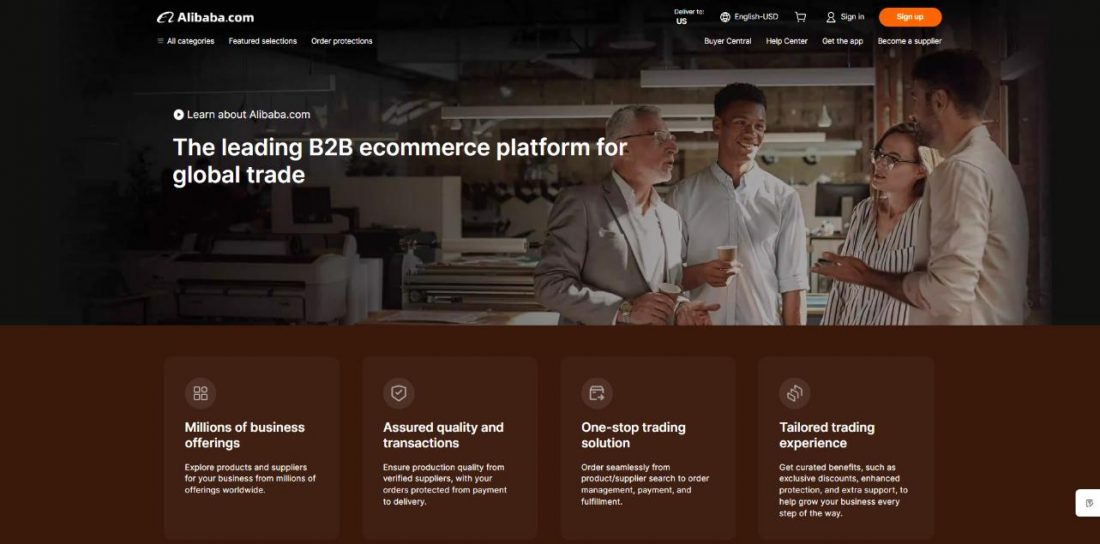
Alibaba is the Amazon equivalent in the world of the B2B ecommerce marketplace. Apart from that, it is also a B2C and C2C online platform to sell products. It is operating in over 180+ countries. Alibaba harbors 40 million active buyers and is thus the best platform to sell online. It connects wholesalers or manufacturers with global resellers/ buyers, which makes it a favourite among other top online marketplaces.
Alibaba reached a valuation of 130.35 billion U.S. dollars in the fiscal year of 2024. However, very recently, it has been noted that its valuation has dropped to $216.6 billion, which is almost 80 per cent less than its peak.
Alibaba marketplace fees
Alibaba charges a membership fee for Gold Suppliers and a transaction fee based on the value of the order. The standard membership fee starts from $166 per month. Alibaba has a zero commission fee policy on sales, but membership is essential to sell on this online marketplace.
How to set up an Alibaba account
To use this platform to sell products online, follow these simple steps,
- Go to their official website.
- Click on ‘Start selling’
- Choose a membership plan
- Sign in
- Create your company profile.
- List your products with detailed descriptions and images to attract buyers.
Organic Website Traffic in 2025: 20,233,406/month
9. Wish
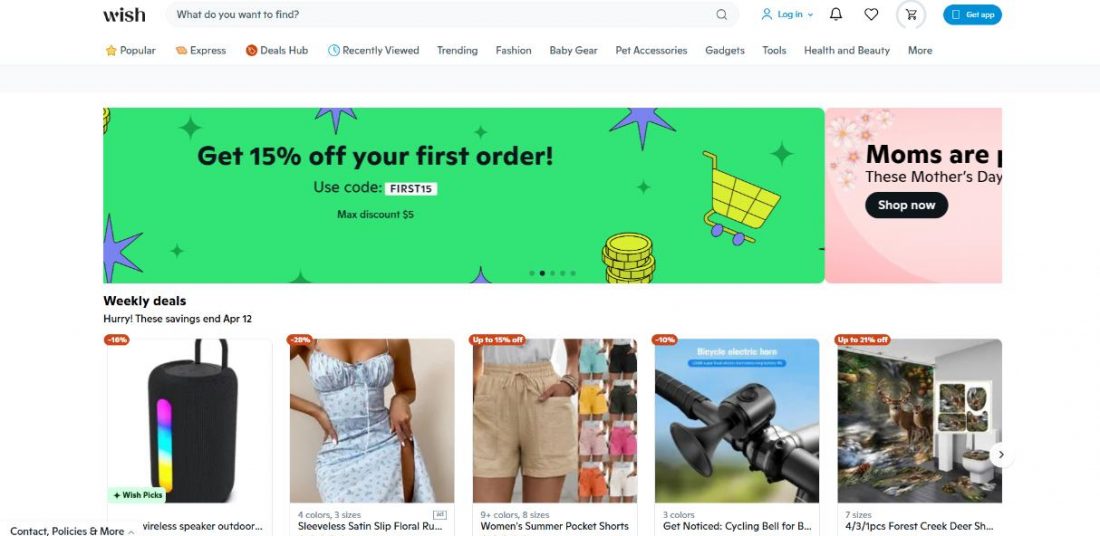
Wish is another D2C ecommerce marketplace from the East, ideal for budget-friendly items at cheaper rates. Although Wish has a bad rep for its lack of quality control, it is still one of the most popular online selling platforms in the world. At Wish, sellers can find low-cost, high-demand items, particularly in categories such as electronics and fashion.
If you’re pursuing the idea of selling on this platform, consider Wish’s Boost feature to promote products for maximum visibility. Furthermore, the Wish Express program can help you deliver products the fastest with maximum ease, and Fulfillment by Wish (FBW) can help you with warehousing and delivery. All of these features make it one of the easiest and best marketplaces to sell online.
Wish Marketplace Fees
Wish charges a commission fee of 11.7% to 19.5% with a transaction fee of $0.30 USD per item. No extra charges for listing.
How to set up a Wish account
To use this platform to sell products online, follow these simple steps,
- Go to Wish.com
- Create your user account by adding your name, email address, and password.
- Verify email to sign up.
- Follow the instructions step by step to get your account ready.
Organic Website Traffic in 2025: 869,631/month
10. Allegro

Allegro is a Polish online platform to sell products. Allegro comes up with frequent promotional campaigns for sellers to reach the customers better. Catering to 20+ million active buyers in Poland, the platform Allegro hit a revenue of over 10.2 billion zloty (equivalent to 2651490000 United States dollars). Allegro is successfully extending its reach to regions like the Czech Republic, Slovakia, and Hungary, as an online marketplace platform and is potentially winning over 16+ million potential customers.
Allegro marketplace fees
Allegro allows free listing for most categories, unlike most other online selling platforms. A commission fee is levied that varies with product category, which ranges around 3%-17%.
How to set up an Allegro account
To use this platform to sell products online, follow these simple steps,
- Go to the registration page
- Choose between a regular account or a business account, and enter your email. Register’.
- Find a confirmation email in your mailbox and click ‘Confirm registration’ to take it forward and get registered.
- List your products.
- Customize your store profile and participate in Allegro’s marketing programs.
Organic Website Traffic in 2025: 191,792/month
11. Facebook Marketplace

If you’re considering spreading your reach to community marketplaces, such as Facebook Marketplace is not your regular ecommerce website to sell products. You’ll be catering to 3 billion+ customers, which is more than any top online marketplaces. You get to escape the hassle of interaction with complex store setups and seamlessly reach potential customers through Facebook, where they may be idly scrolling through funny videos.
According to Statista, every 1 out of 4 global online shoppers chooses Facebook over others for social commerce.
In order to close a deal, sellers simply need to communicate with buyers directly and build a foundation of trust. Both parties benefit from this firsthand communication. But we cannot consider Facebook Marketplace as one of the full-fledged online selling platforms, so expect limited marketing or analytics features. Consider it as one of the low-barrier, high-potential ecommerce marketplace platforms.
Facebook marketplace fees
Keeping that aside, there are massive benefits of Facebook Marketplace. A major one is the minimal fee. No listing fee; hence, it can give you an easy head start, a 10% selling fee from the payout, and a 2.9% card processing fee.
How to set up a Facebook marketplace account
To use this platform to sell products online, follow these simple steps,
- Access Facebook Marketplace through your Facebook account.
- Go to the Facebook homepage
- Click the Marketplace icon, which looks like a storefront
- Set your location on the app
- Create a listing with high-quality product details and images.
- Communicate with buyers through Facebook Messenger to make sales.
Organic Website Traffic in 2025: 4,089,945,695/month
12. Wayfair
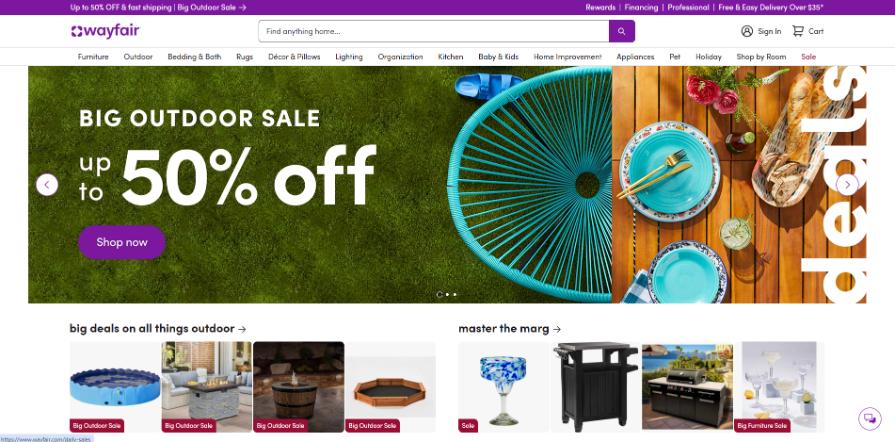
If you’re a seller of home goods on online selling platforms, Wayfair is your place to be. Be it artsy decor accessories, furniture, or curtains, Wayfair has multiple categories.
Wayfair operates on an invite-only ecommerce website to sell products, a dropship model where sellers act as suppliers. This ecommerce marketplace is striving to build a stellar reputation, and to make it happen in actuality, they ask for a valid business registration number of sellers willing to list their items on Wayfair.
Wayfair’s Supplier Code of Conduct is pretty strictly maintained like other top ecommerce marketplaces. The Partner Home platform of Wayfair (similar to Amazon Seller Central) offers tools to help sellers with inventory and order tracking, and shipping label printing.
Wayfair marketplace fees
Although it is the best ecommerce marketplace for selling furniture, Wayfair doesn’t cost you setup fees, listing fees, or even subscriptions. Instead, they operate on a wholesale cost model. What is it? It is where sellers offer the goods to Wayfair at a wholesale rate, but Wayfair lists the item at a higher retail price and keeps the profit. It also covers shipping fees.
How to set up a Wayfair marketplace account
Since it is not an open marketplace, there is only a limited part that you can play here. But it is the best ecommerce marketplace for people searching for quality.
- Visit Wayfair’s Partner Application page
- Add details about your business, including product catalog and fulfillment capabilities
- Submit your application and wait for the team at Wayfair to get back to you.
Organic Website Traffic in 2025: 12,936,709/month
13. Bestbuy
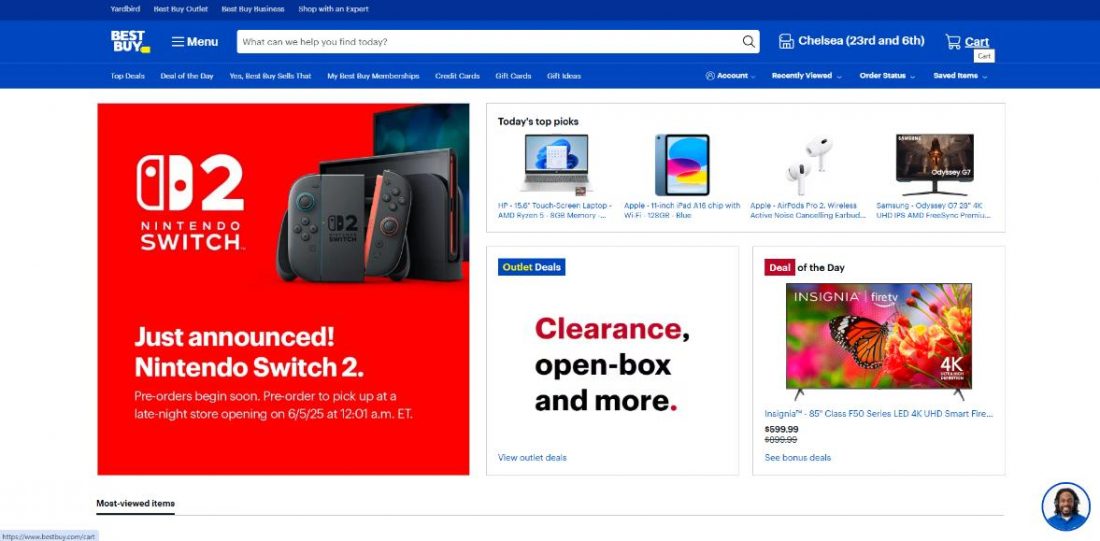
If you’re in search of an ecommerce platform to sell electronics, Best Buy is another choice for you. It has a reputation for delivering quality electronics, appliances, and tech-related accessories. Established in 196,6, BestBuy’s marketplace is invite-only; thus, it has garnered the status of delivering first-rate quality for guarding the standards of products they allow to list.
They evaluate your business based on pricing, the fulfillment options you provide, and the customer service history that you’ve maintained over the years.
Best Buy is indeed the best platform to sell online electronics goods. According to their website, they have 200 million+ customers worldwide. The reason for the popularity is expected to be the tech support plans, the extended warranty plans, and the subscription plans for discounts.
BestBuy Marketplace fees
BestBuy ecommerce marketplace charges a referral fee of 8% levied on the total selling price. The referral charge may differ from a minimum fee of $1.00 and a maximum fee of $250.00. An added closing fee is also imposed that fluctuates from $0.45 to $1.35 per item sold.
How to set up a BestBuy marketplace account
To use this platform to sell products online, follow these simple steps,
- Submit an application by filling out the application form on the Best Buy Marketplace website
- Best Buy will review your application.
- Create a store setup using integration tools and dedicated account management tools.
- Get additional support with the Seller Program for the first 90 days of launch.
Organic Website Traffic in 2025: 45,795,012/month
14. Flipkart

Flipkart is India’s homegrown best platform to sell online, which, compared to all other online selling platforms, has penetrated tier 1, 2, and 3 cities with equal weightage. It has revolutionized the online shopping scene in India since its launch in 2007.
Flipkart, almost like Amazon, started as a humble online bookstore and has now evolved into an ecommerce marketplace powerhouse. Backed by Walmart’s $16 billion investment, Flipkart offers sellers a thriving platform, a channel to reach various levels of the Indian population. If you’re willing to extend the market to a price-sensitive, vast demand market, Flipkart is among the top online marketplaces to go for.
With the vast customer reach and seamless logistics of the in-house shipping partner, Ekart. SellerApp can make your entry into the Flipkart ecommerce marketplace a seamless affair. Just get in touch with the SellerApp team.
Flipkart marketplace fees
Flipkart’s commission fee is around 5% to 25% of the selling price, with a fixed fee of
₹10-30 below ₹500, ₹30-60 for items worth ₹500 – ₹1,000 and ₹1,000 for above ₹60-100
How to set up a Flipkart marketplace account
To use this platform to sell products online, follow these simple steps,
- Visit the Flipkart Seller Hub.
- Click on “Start Selling”.
- Enter contact details
- Enter GSTIN or PAN, verify your email address, draw your signature, add your business address, and pickup address. Enter bank details and you’re good to go.
Organic Website Traffic in 2025: 189,940,397/month
15. Temu
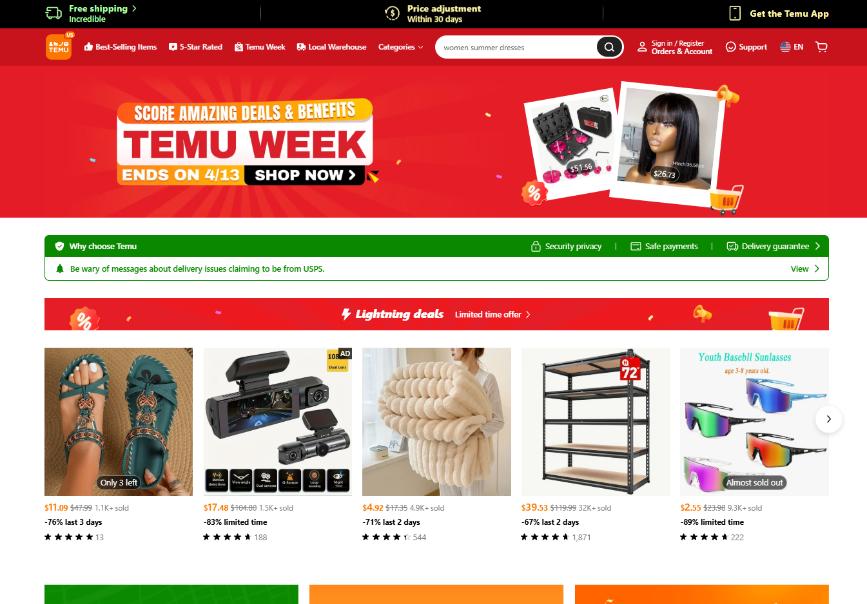
Temu made a bangin’ entry with a GMV of USD 290 million in 2022, which spiked up to USD 12.26 billion in 2023, and now in 2025, it is only thriving.
Temu, being a subbrand of Chinese conglomerate PDD Holdings, walks the path of volume-based sales, where it aims to attract price-sensitive customers by offering economical products.
If you’re searching for top online marketplaces to sell categories such as home items, kitchen appliances, electronics, and fashion, you can get a quick head start with Temu, as they have very few restrictions on quality. You can easily enter the ecommerce marketplace; all you need is a reliable supplier.
Temu marketplace fees
To sell on Temu, you’ll have to pay a subscription of $39 monthly and a commission fee on each sale, which is usually 2% to 5% of the sale price, which is deducted from the seller’s earnings.
How to set up Temu marketplace account
To use this platform to sell products online, follow these simple steps,
- Request a Temu seller account from the Pinduoduo seller app.
- Submit the required documents
- Get Temu seller credentials
- Create a Temu seller account and profile
- Add product listings and provide self-fulfillment
Organic Website Traffic in 2025: 38,664,359/month
Which online selling platforms should you choose?
Although there’s no complex formula when it comes to choosing the best ecommerce marketplace to sell on. We do recommend you consider the following:
- Nature and audience of the platform
- Its limitations,
- Your business goals,
- Your audience type, and
- Your operational capabilities
The last three especially are significantly important to understand before you zero in on the right marketplace for your needs.
Here’s a breakdown:
1. Open Marketplaces
These marketplaces are platforms that allow any seller to join and list their products or services for sale in exchange for a selling fee.
Although it looks like these platforms come with minimal barriers to entry, you’ll have to prove your legitimacy. Sales license requirement varies from platform to platform, but every aspiring seller will have to undergo the process of verification. With open marketplaces, you can reach a large audience with a click of your finger, but that comes with the cost of heightened competition.
After all, if it is easy and effective, everyone would want it. So there are paid tools for marketing that ensure you stand out from the crowd.
The drawback? These ecommerce marketplaces may charge significant fees, which can impact your profit margins.
For example, Amazon is known for its vast customer base and extensive product categories. Amazon allows anyone to become a seller after some quality checks. This can be beneficial for gaining exposure to a large audience, but the competition can be tough, and sellers must follow strict guidelines and fees.
2. Private Marketplaces
These ecommerce marketplaces are more on the exclusive side.
They mostly let sellers in only via an application process (where you are asked to fill out a form, and the internal team of the platform reaches out to you once you meet the cut-off), or an invitation is directly sent to you. For example, Alibaba and Allegro follow the former process. Target and Wayfair follow the latter.
These platforms tend to be more niche and controlled. Private ecommerce marketplaces allow you to maintain a better brand reputation and have better control over the customer experience.
For instance, when you sell products on Target, you tend to share the quality status with it. Whereas you, as a brand, uphold certain quality standards while being a part of this particular online marketplace platform, you add to its reputation.
If you sell niche or high-end products, then private marketplaces can provide you access to a more targeted, higher-value customer base.
For example, Wayfair specializes in home goods and furniture. This shows that they are selective about their vendors, ensuring a consistent quality of products.
What are the benefits of selling on online selling platforms?
Let’s look at the top advantages of selling online:
Fast launch
If you’re new to selling online, ecommerce marketplaces can be the most sought-after way to enter the scene and build your brand as you work to drive traffic to your products. Not only that, you get a channel to reach out to high-intent customers, but you also get a variety of tools to optimize your products for maximum visibility. As the customer base is already present, simply listing your product and optimizing it marks your market entry. It is fast and requires less effort.
Additional Read: How Fashion eCommerce Retailers Can Reduce Online Returns
Established programs
The biggest and most established online marketplaces have programs in place to help you tap into the strategies of marketing, selling, and fulfillment without any hassle.
For example, sellers on Amazon can access Amazon advertising, opt for FBA to let Amazon fulfill their orders and so much more. Each of these programs is packed with tools to help you get products in front of all the right audiences at just the right times. But sometimes, that’s not enough.
These marketplaces are highly competitive and therefore, you need to apply the best industry practices to sell. Now, this isn’t possible without leveraging data insights. That’s why you need a powerful solution in the market to charge up your Amazon sales potential and maximize ad ROI, optimize product sourcing and listing, and more.
Large customer bases
The biggest marketplaces are not just famous for their smooth UX, they also have enormous audiences of consumers who regularly shop at these sites. For example, if you are selling on Amazon, you can reach out to 310 million Amazon shoppers.
56% of all product searches now begin (and often end) on Amazon. This means that these customers don’t even look at other retail sites before placing an order. This level of customer loyalty is something you cannot overlook. Hence, being a third-party seller will bring you recognition as well as profit.
However, sellers at ecommerce marketplaces go through a cutthroat competition that’s very difficult to see through. Your products might not even appear in search results, while your competitors dominate the rankings.
Why? Because they’ve mastered strategic selling, leveraging data-driven insights and third-party, AI-powered solutions to strengthen their brand and outpace the competition.
Hence, to beat your competitors, you need the help of industry experts to assist you with the best listing practices and advertising strategies to boost your sales to the optimum level.
Your operational efficiency will be at its best, and your revenue potential will skyrocket.
Important factors to research before you sell on online selling platforms
Whether you’re a small start-up looking to build your business or you’re an established seller looking to expand, online marketplaces are great platforms to sell on.
However, you must consider a few things before you jump right into the online retail business.
Here are five important factors you should research before you start to sell online
Marketplace traffic
While the quality of visitors and their intent is inherently more important, understanding the level of website traffic is still worthwhile. Particularly if you’re looking at the less-established, niche online selling platforms, having a clear judgment of traffic is absolutely necessary.
For example, if you wish to sell home decor items, it’s best to choose Amazon or Etsy as your ecommerce marketplace rather than eBay, as Amazon witnesses 30% more sales on home and outdoor products, as compared to eBay.
Fee structure
When selling on an online selling platform, there are fees and other marketing costs that you need to consider. Start by researching the site’s fee structure and figure out whether they only charge selling commission or also charge listing fees, as well.
You will also need to consider any potential additional fees, including inventory costs, shipping fees, marketing fees, and any other costs that could be incurred through the use of complementary support.
For example, Etsy charges zero listing fee, so sellers with a broader product catalogue can benefit from it.
Support from the marketplace
It’s important to know that the majority of ecommerce marketplaces offer support to help sellers get the most from their site, whether through delivery scheduling software, or other tools for marketing and sales, or having access to a dedicated advertising console.
Online selling platforms tend to provide sellers with APIs to help them succeed and scale faster. These marketplace APIs allow sellers to bulk upload products, collect product data to forecast sales, and establish predictive models.
However, these ecommerce marketplace platform APIs often do not offer clean data, and it can take time to gather visible insights. Instead, you can depend on third-party APIs like SellerApp’s ecommerce data APIs to fill in any gaps. These third-party APIs can provide more refined data and analytics, helping you make better-informed decisions and optimize your business processes.
Rules and regulations
Despite the benefits of selling on a marketplace, it should come as no surprise that as a third-party seller, you will have far less flexibility and control over your business than you’d have if you had your own website.
For instance, it might be difficult to create brand awareness on some marketplaces, although some sites will enable you to create your own store within the marketplace. Many online marketplaces offer features to help elevate your brand presence, such as Amazon A+ content and other promotional tools.
Geographic popularity
Another important factor to consider is how prominent and popular the top online marketplaces are in your region or your target selling location, and how the masses are accepting these concepts. The zipcode-level relevance is important to understand and target specific geographic areas to optimize sales performance.
For example, a seller might find that their outdoor equipment sells exceptionally well in zip codes encompassing mountainous regions, while their beachwear has higher demand in coastal areas. By analyzing sales data at this granular level, sellers can tailor their marketing efforts, manage inventory more efficiently, and provide better delivery options to meet local consumer preferences, ultimately enhancing customer satisfaction and boosting sales.
Recommended read: What is the registration process for Walmart Plus?
Top 5 countries dominating online selling platforms
Expanding into global ecommerce isn’t just about picking online selling platforms—it’s about choosing the right market. Some countries are primed for online retail, while others are still catching up. Let’s dive into the 5 biggest ecommerce powerhouses and what makes them a goldmine for sellers.
1. United States
If ecommerce had a capital, where people have endless demand, it would be the United States. Born out of the US, ecommerce giants like Amazon and eBay are thriving solely due to the fact that online shopping is second nature to that population. Consumers are confidently buying from international sellers due to the presence of well-regulated ecommerce marketplaces. If you’re planning to jump right in, the US market is the most profitable for a head start.
Why is the US market important for global ecommerce?
- People here spend more per order than in most other countries.
- The logistics infrastructure is top-notch, making cross-border fulfillment seamless.
- For sellers outside the U.S., the challenge is competition. If you want to succeed here, your pricing, branding, and customer service need to be on point.
2. China
China’s ecommerce scene isn’t just big, it is ginormous and self-sufficient as an ecosystem. Platforms like Tmall, JD.com, and Pinduoduo give Amazon a run for its money.
Why is the Chinese market important for global ecommerce?
- Chinese ecommerce websites to sell products are supported by over one billion online shoppers, which is more than the combined user base of the U.S. and Europe.
- Cross-border shopping is very common especially fuelled by platforms like Tmall Global where international brands can easily create their presence in the country.
- Chinese consumers love premium international items, especially in beauty, fashion, and health.
Selling in China isn’t as simple as listing a product. You need to understand local platforms, adapt to mobile-first shopping, and, most importantly, build trust, because Chinese shoppers are incredibly brand-conscious.
3. United Kingdom
The UK is one of the most seasoned ecommerce markets in the world, but what makes it really special is its cross-border potential. Thanks to its digital-savvy population and widespread use of platforms like Amazon UK, eBay, and Etsy, the UK is a prime spot for international sellers trying to create a presence beyond the US.
Why is the UK market important for global ecommerce?
- British consumers have a strong preference for international brands and ethnic items.
- English is the primary language, which means it is easier to localize platforms and communication for global sellers.
But be wary of new tax and import regulations.
4. Germany
It’s the largest ecommerce market in Europe, and German shoppers are known for their loyalty and willingness to pay more for quality. If you’re selling premium products, Germany is an opportunity you can’t ignore.
Why is the German market important for global ecommerce?
- German consumers are quality-driven, and they’re willing to pay more for trusted brands.
- The country has some of the best logistics and fulfillment services in Europe, making delivery fast and reliable.
For cross-border sellers, the challenge is localization. German shoppers expect listings, clear return policies, and customer service in their native language. Get that right, and you’ll build a customer base that keeps coming back.
5. India
With platforms like Flipkart, Amazon India, and Meesho, India is the fastest-growing ecommerce space. The country’s young population and increasing internet penetration make it one of the ecommerce dominant markets with ample opportunities.
Why is the Indian market important for global ecommerce?
Mobile commerce is booming—most purchases happen on smartphones.
Indian consumers trust international brands, and there is a growing taste for premium brands due to the rapid rise in middle-class population.
Selling in India comes with challenges. Price sensitivity is high, and logistics can be tricky, but the upside is enormous. Keep your pricing competitive, have strong brand positioning, and mobile-friendly shopping experiences.
Final thoughts
There are plenty of online marketplaces to opt for; therefore, to find the best match, you have to be clear on your goals and requirements. Each platform has a unique feature suite and is geared towards different types of sellers and their product niches.
If there is more than one marketplace that meets your needs, then feel free to register yourself on more than one.
SellerApp helps businesses succeed on various marketplaces by providing them with solutions such as enhanced products, pricing, and advertising data to help them scale their business quickly. Get in touch with us to leverage multiple online selling platforms to skyrocket your business. Our PPC experts will get in touch with you ASAP!
Read More:
Amazon Competitors Giving the Ecommerce Giant a Run for its Money


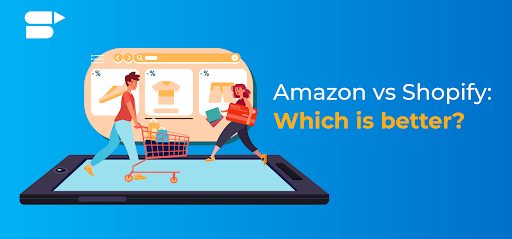


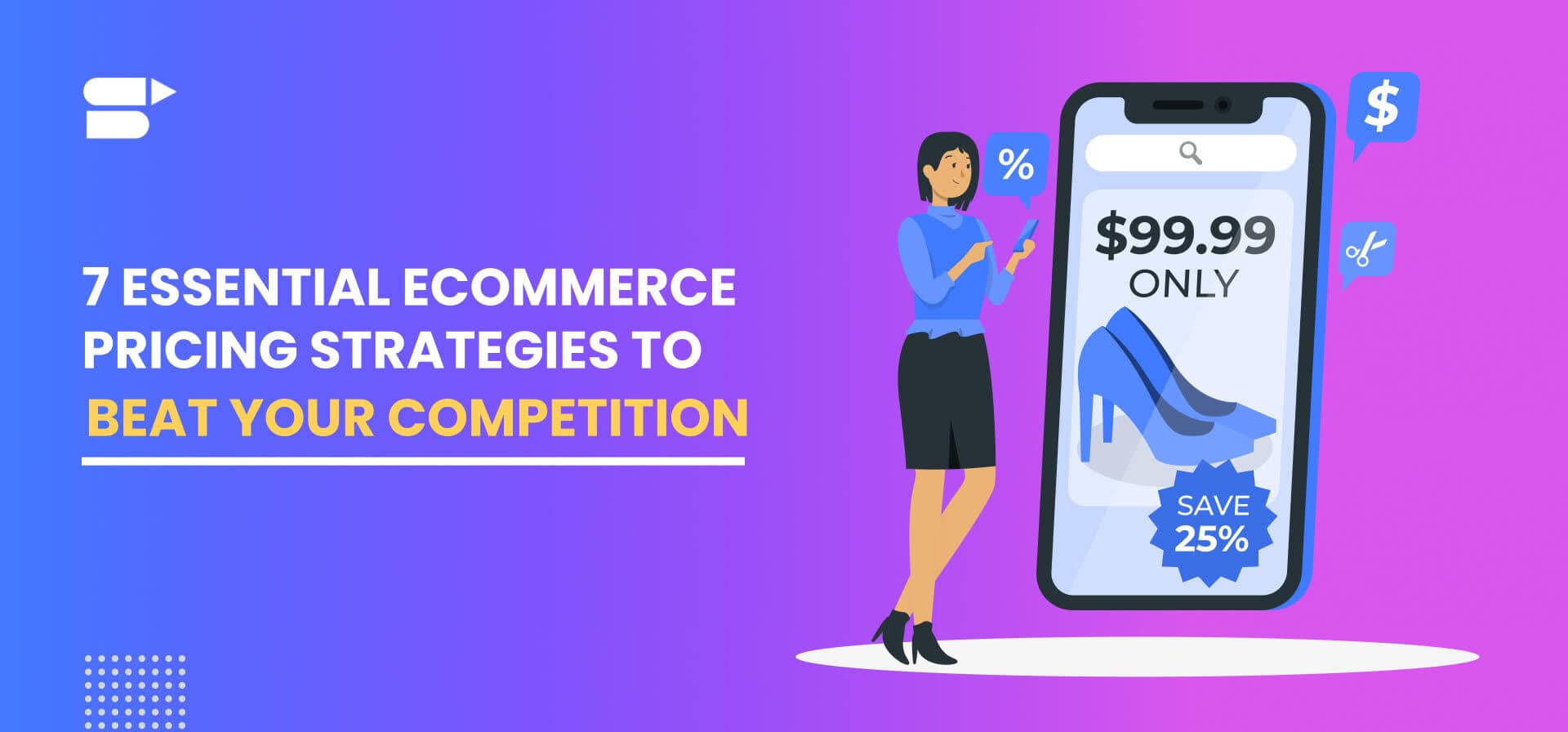





Harrison
June 24, 2024Thanks for this post! It was very helpful and informative.
Clare Thomas
July 3, 2024Very happy to hear that.
Chris
June 25, 2024Very insightful! This post answered a lot of my questions.
Clare Thomas
July 3, 2024Thank you for your valuable feedback.
Tim David
June 26, 2024Can I sell digital products on these marketplaces?
Clare Thomas
July 3, 2024Yes, you can sell digital products on marketplaces like Etsy and Amazon. Etsy is particularly well-suited for digital downloads like printables and design templates, while Amazon allows for the sale of eBooks and other digital content through Kindle Direct Publishing.
Logan Brooks
August 22, 2024Appreciate the details.
Clare Thomas
September 23, 2024Thanks!
Matthew Alexander
August 27, 2024Really valuable.
Clare Thomas
September 23, 2024Glad you like it.
Maxwell Joseph
September 6, 2024Helpful article.
Clare Thomas
September 23, 2024thank you.
Carter Anthony
September 15, 2024Excellent advice.
Clare Thomas
September 23, 2024Thanks for your feedback.